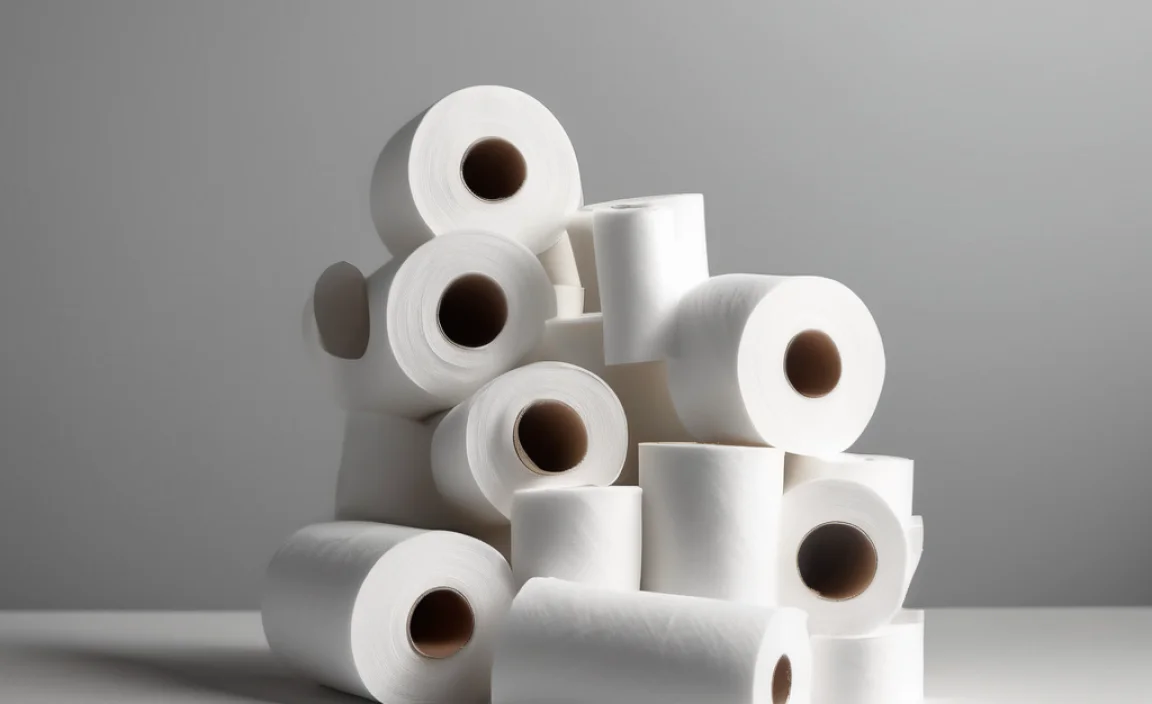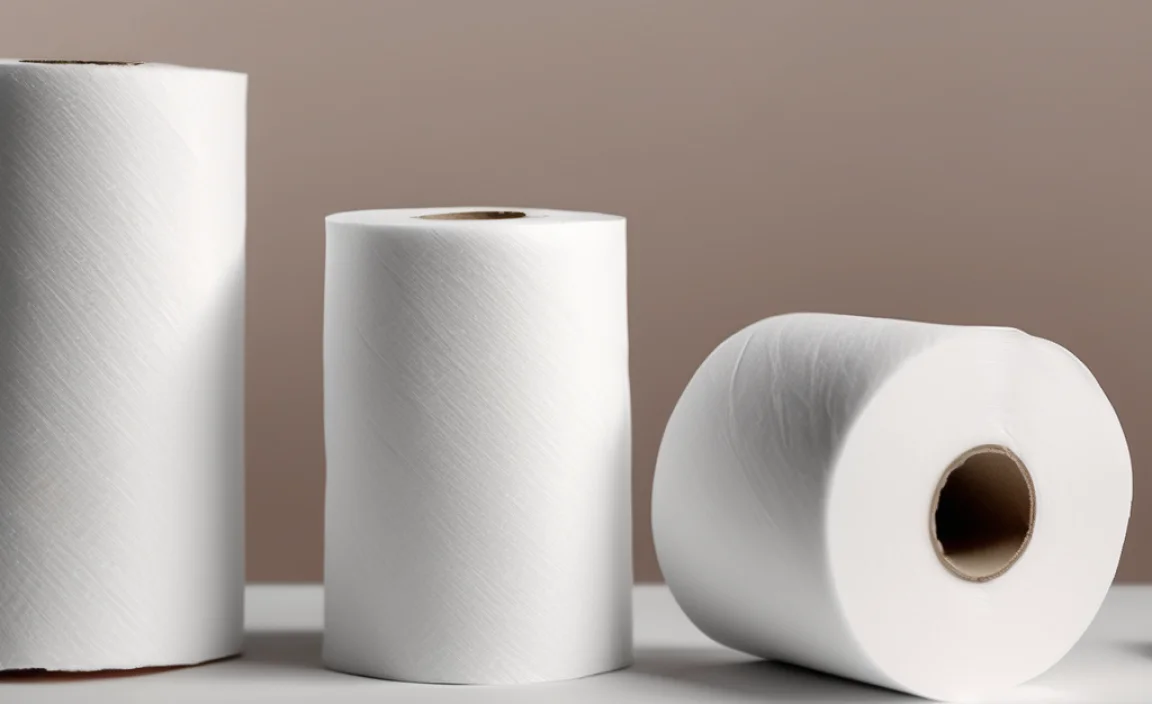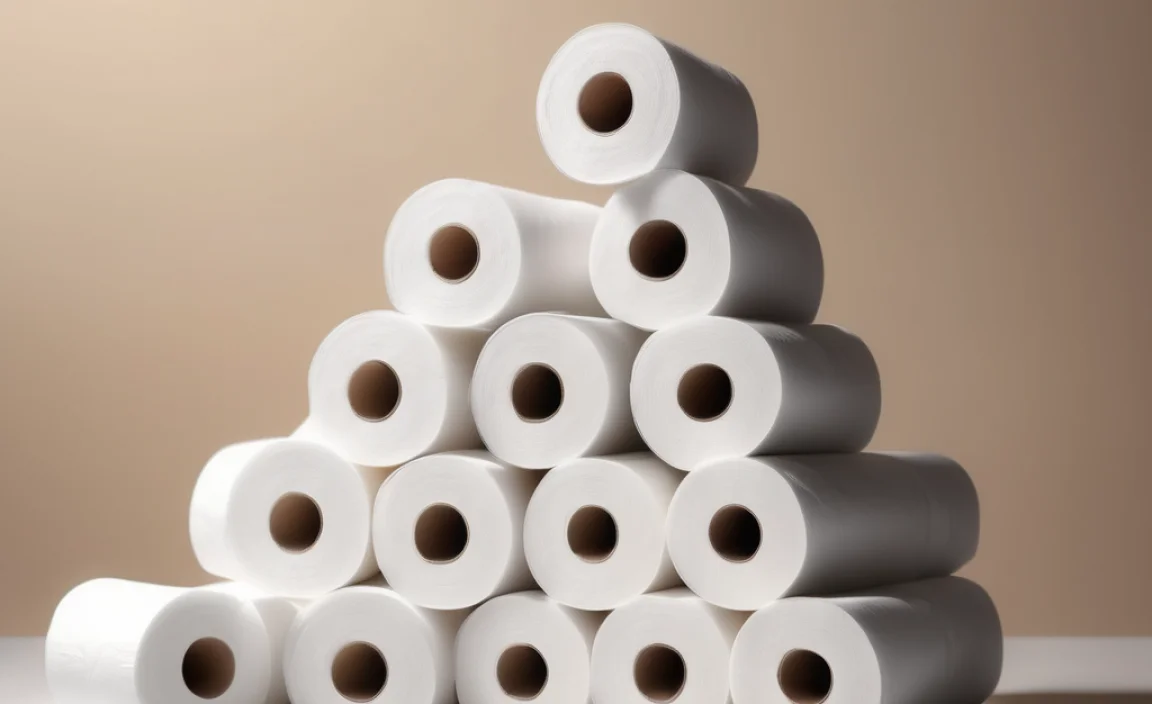Quick Summary: On average, a person uses about half a roll of toilet paper per week. This means a family of four might use two rolls weekly. However, usage can vary based on habits, the toilet paper’s quality, and other factors. Keep reading to learn how to estimate your household’s needs accurately and save money!
Ever wondered how much toilet paper your household really needs? It’s a common question, and figuring it out can save you from running out at the worst moment—or buying way too much. Knowing your household’s average usage helps you budget and reduce waste.
In this guide, we’ll walk you through a simple, step-by-step method to calculate your toilet paper needs. We’ll cover factors that influence usage, how to track your consumption, and tips for buying smarter. Ready to stop guessing and start knowing? Let’s get started!
Understanding Toilet Paper Consumption

Before diving into calculations, it’s important to understand what affects toilet paper usage. Several factors can significantly change how quickly you go through a roll.
Factors Influencing Toilet Paper Usage
- Number of People in the Household: More people mean more usage. A single person will use far less than a family of five.
- Personal Habits: Some people use more toilet paper per visit than others. Habits vary widely!
- Toilet Paper Quality: Thicker, more absorbent toilet paper might mean using less per visit.
- Diet: A diet high in fiber can increase bathroom visits.
- Health Conditions: Certain health issues can also increase frequency.
- Age: Young children might use more as they are learning hygiene.
Consider these factors when estimating your household’s needs. Now, let’s look at how to track your usage.
Step-by-Step Guide to Tracking Toilet Paper Usage
Tracking your toilet paper consumption doesn’t have to be complicated. Here’s a simple method to get a clear picture of your household’s usage.
Step 1: Establish a Baseline
Start by noting how many rolls you currently have and when you start tracking. This is your baseline.
Step 2: Track Usage Over a Few Weeks
For the next 3-4 weeks, keep a log of every roll of toilet paper your household uses. Note the date each roll is started and finished.
Step 3: Record Your Findings
Keep a simple record. Here’s an example of how you might log your data:
| Roll Number | Date Started | Date Finished |
|---|---|---|
| 1 | 2024-01-01 | 2024-01-04 |
| 2 | 2024-01-04 | 2024-01-07 |
| 3 | 2024-01-07 | 2024-01-10 |
Step 4: Calculate Weekly Usage
At the end of each week, calculate how many rolls were used. Add up the total number of rolls used and divide by the number of weeks you tracked.
Example: If you used 6 rolls over 3 weeks, your weekly usage is 6 rolls / 3 weeks = 2 rolls per week.
Step 5: Determine Individual Usage
To find out how much each person uses, divide the weekly household usage by the number of people in your home.
Example: If you use 2 rolls per week as a household of four, each person uses approximately 2 rolls / 4 people = 0.5 rolls per person per week.
Estimating Usage Based on Household Size

If you prefer a quick estimate, here’s a general guide based on household size. Keep in mind that these are averages, and your actual usage may vary.
| Household Size | Estimated Rolls Per Week | Estimated Rolls Per Month |
|---|---|---|
| 1 Person | 0.5 roll | 2 rolls |
| 2 People | 1 roll | 4 rolls |
| 3 People | 1.5 rolls | 6 rolls |
| 4 People | 2 rolls | 8 rolls |
| 5 People | 2.5 rolls | 10 rolls |
Use this table as a starting point, then adjust based on your tracking results.
Choosing the Right Toilet Paper

The type of toilet paper you choose can impact how much you use. Here’s what to consider.
Types of Toilet Paper
- 1-Ply: Thinner and less expensive. You might use more per visit.
- 2-Ply: A good balance of thickness and cost.
- 3-Ply: Thicker and more absorbent, often meaning you use less.
- Quilted: Soft and absorbent but can be more expensive.
- Recycled: Made from recycled materials, an eco-friendly option.
Factors to Consider When Choosing
- Absorbency: More absorbent paper means using less.
- Softness: Softer paper can be more comfortable.
- Cost: Balance quality with your budget.
- Environmental Impact: Consider recycled options to reduce waste.
Experiment with different types to find what works best for your household. Sometimes, spending a bit more on quality can save you money in the long run by reducing the amount you use.
Tips for Reducing Toilet Paper Consumption

Want to use less toilet paper? Here are some practical tips.
Practical Tips
- Use Less: Be mindful of how much you’re using. Encourage family members to do the same.
- Consider a Bidet: Bidets reduce the need for toilet paper. They use water to clean, leaving you feeling fresher.
- Use Toilet Paper Alternatives: For some tasks, like cleaning up small spills, use paper towels or reusable cloths instead.
- Proper Diet: A balanced, fiber-rich diet can promote regular bowel movements, potentially reducing the need for excessive wiping. Refer to the Mayo Clinic’s guidelines on dietary fiber for more information.
- Educate Children: Teach kids about appropriate toilet paper usage early on.
- Address Health Issues: Consult a doctor if health conditions are causing increased bathroom visits.
Smart Buying Strategies
Buying toilet paper in bulk can save you money, but only if you have the storage space and know you’ll use it. Here are some strategies for smart buying.
Bulk Buying vs. Regular Buying
- Bulk Buying:
- Pros: Often cheaper per roll, reduces shopping trips.
- Cons: Requires storage space, risk of overbuying if usage changes.
- Regular Buying:
- Pros: Less storage needed, easier to adjust to changing needs.
- Cons: Can be more expensive per roll, requires more frequent shopping.
Tips for Saving Money
- Compare Prices: Check prices at different stores and online retailers.
- Use Coupons: Look for coupons in newspapers, online, and in-store.
- Buy on Sale: Stock up when toilet paper is on sale.
- Consider Store Brands: Store brands are often cheaper than name brands and can be just as good.
- Subscribe and Save: Some online retailers offer discounts for subscribing to regular deliveries.
Storing Toilet Paper Properly
Proper storage keeps your toilet paper clean and ready to use. Here’s how to store it effectively.
Storage Tips
- Dry Place: Store toilet paper in a dry area to prevent moisture damage.
- Avoid Direct Sunlight: Sunlight can fade the paper and damage packaging.
- Use Storage Containers: If space is limited, use storage containers to keep rolls organized.
- Keep Some in the Bathroom: Have a few rolls readily available in the bathroom, but store the bulk in a closet or cabinet.
- Elevated Storage: In damp environments, elevate toilet paper off the floor to prevent moisture absorption.
Environmental Considerations
Choosing eco-friendly toilet paper options can reduce your environmental impact. Here’s what to look for.
Eco-Friendly Options
- Recycled Toilet Paper: Made from recycled paper, reducing the need for new trees.
- Bamboo Toilet Paper: Bamboo is a fast-growing, sustainable resource.
- Unbleached Toilet Paper: Avoids the use of harsh chemicals in the bleaching process.
- FSC Certified: Look for the Forest Stewardship Council (FSC) certification, ensuring responsible forest management.
Benefits of Eco-Friendly Choices
- Reduced Deforestation: Helps protect forests by using recycled or sustainable materials.
- Lower Carbon Footprint: Reduces the energy and resources needed to produce toilet paper.
- Less Pollution: Avoids the use of harmful chemicals in the manufacturing process.
Toilet Paper Alternatives
While toilet paper is the norm, there are alternatives to consider, each with its own pros and cons.
Popular Alternatives
- Bidets:
- Pros: Reduces toilet paper use, hygienic, environmentally friendly.
- Cons: Initial cost, requires installation.
- Reusable Cloth Wipes:
- Pros: Environmentally friendly, cost-effective long term.
- Cons: Requires washing, storage of used wipes.
- Water Wipes:
- Pros: Convenient, gentle on skin.
- Cons: Can be expensive, not as environmentally friendly as other options.
FAQ: Toilet Paper Usage
How many sheets are in a standard roll of toilet paper?
A standard roll typically has between 300 and 500 sheets, but this can vary by brand and type.
Is it better to buy toilet paper in bulk?
Buying in bulk can save money if you have storage space and know you’ll use it, but compare prices and consider your needs.
What’s the most eco-friendly type of toilet paper?
Recycled or bamboo toilet paper are the most eco-friendly options, as they reduce deforestation and resource use.
How can I reduce my household’s toilet paper usage?
Be mindful of how much you use, consider a bidet, and educate children about proper usage.
Are store-brand toilet papers as good as name brands?
Store brands can be just as good and are often cheaper. Try different brands to find one that suits you.
How does toilet paper quality affect usage?
Higher quality, more absorbent toilet paper often means you use less per visit, saving you money in the long run.
What is a bidet, and how does it reduce toilet paper usage?
A bidet is a device that uses water to clean you after using the toilet, greatly reducing or eliminating the need for toilet paper.
Conclusion
Calculating your household’s toilet paper needs doesn’t have to be a mystery. By tracking your usage, considering influencing factors, and making smart buying choices, you can manage your supply effectively. Remember to choose quality toilet paper, consider eco-friendly options, and explore alternatives like bidets to reduce waste.
Take the steps outlined in this guide, and you’ll be well-equipped to estimate your toilet paper consumption accurately. This will help you save money, reduce waste, and ensure you never run out at the wrong time. Happy calculating!


